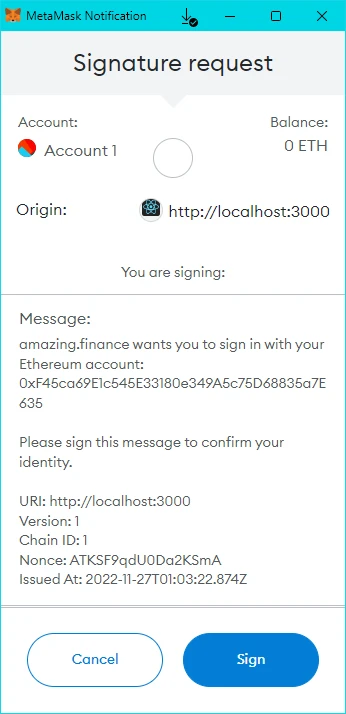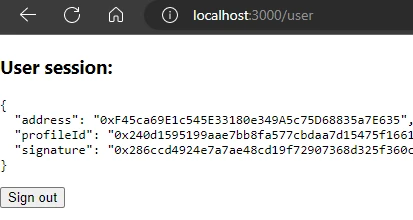How to Authenticate Users with MetaMask using React
Learn how Moralis authentication works and see how to add secure authentication to your React dapp. This tutorial covers how to create full-stack Web3 authentication using the popular React framework.
Introduction
This tutorial demonstrates how to create a React app that allows users to log in using their Web3 wallets.
After Web3 wallet authentication, the server creates a session cookie with a signed JWT stored inside. It contains session info (such as an address, signed message) in the user's browser.
Once the user is logged in, they will be able to visit a page that displays all their user data.
Prerequisites
- Follow the Your First Dapp - React tutorial to set up your React dapp and server
Install the Required Dependencies
To implement authentication using a Web3 wallet (e.g., MetaMask), we will use a Web3 library. For the tutorial, we will use wagmi.
- Install
wagmiandviemin your React app:
- npm
- Yarn
- pnpm
npm install wagmi viem
yarn add wagmi viem
pnpm add wagmi viem
Initial Setup
First we will add an environment variable that will be used when calling our API.
- Create a file called
.envin the root of your react project (wherepackage.jsonis) and add:
REACT_APP_SERVER_URL=http://localhost:4000
Next we will add the providers required for wagmi.
- Open
src/App.jsand add our required imports:
import { createConfig, configureChains, WagmiConfig } from "wagmi";
import { publicProvider } from "wagmi/providers/public";
import { mainnet } from "wagmi/chains";
import Signin from './signin';
import User from './user';
- We will add the client and providers, and update the routes for our
/signincomponent (to be set up next):
const { publicClient, webSocketPublicClient } = configureChains(
[mainnet],
[publicProvider()]
);
const config = createConfig({
autoConnect: true,
publicClient,
webSocketPublicClient,
});
const router = createBrowserRouter([
{
path: "/signin",
element: <Signin />,
},
{
path: "/user",
element: <User />,
},
{
path: "/",
element: <h1>Home Component</h1>,
},
]);
function App() {
return (
<WagmiConfig config={config}>
<RouterProvider router={router} />
</WagmiConfig>
);
}
export default App;
Your full App.js file should look like this
import { createBrowserRouter, RouterProvider } from "react-router-dom";
import { createConfig, configureChains, WagmiConfig } from "wagmi";
import { publicProvider } from "wagmi/providers/public";
import { mainnet } from "wagmi/chains";
import Signin from "./signin";
import User from "./user";
const { publicClient, webSocketPublicClient } = configureChains(
[mainnet],
[publicProvider()]
);
const config = createConfig({
autoConnect: true,
publicClient,
webSocketPublicClient,
});
const router = createBrowserRouter([
{
path: "/signin",
element: <Signin />,
},
{
path: "/user",
element: <User />,
},
{
path: "/",
element: <h1>Home Component</h1>,
},
]);
function App() {
return (
<WagmiConfig config={config}>
<RouterProvider router={router} />
</WagmiConfig>
);
}
export default App;
Server Setup
Back in our server directory we will update our server's index.js for the code we need for authentication. In this demo, cookies will be used for the user data.
- Install the required dependencies for our server:
npm install cookie-parser jsonwebtoken dotenv
- Create a file called
.envin your server's root directory (wherepackage.jsonis):
- APP_DOMAIN: RFC 4501 DNS authority that is requesting the signing.
- MORALIS_API_KEY: You can get it here.
- REACT_URL: Your app address. By default React uses
http://localhost:3000. - AUTH_SECRET: Used for signing JWT tokens of users. You can put any value here or generate it on
https://generate-secret.now.sh/32.
APP_DOMAIN=amazing.finance
MORALIS_API_KEY=xxxx
REACT_URL=http://localhost:3000
AUTH_SECRET=1234
- Open
index.js. We will create a/request-messageendpoint for making requests toMoralis.Authto generate a unique message (React will use this endpoint on the/signinpage):
// to use our .env variables
require('dotenv').config();
app.use(express.json());
// for our server's method of setting a user session
const cookieParser = require('cookie-parser');
const jwt = require('jsonwebtoken');
const config = {
domain: process.env.APP_DOMAIN,
statement: 'Please sign this message to confirm your identity.',
uri: process.env.REACT_URL,
timeout: 60,
};
app.post('/request-message', async (req, res) => {
const { address, chain, network } = req.body;
try {
const message = await Moralis.Auth.requestMessage({
address,
chain,
...config,
});
res.status(200).json(message);
} catch (error) {
res.status(400).json({ error: error.message });
console.error(error);
}
});
- We will create a
/verifyendpoint for verifying the signed message from the user. After the user successfully verifies, they will be redirected to the/userpage where their info will be displayed:
app.post('/verify', async (req, res) => {
try {
const { message, signature } = req.body;
const { address, profileId } = (
await Moralis.Auth.verify({
message,
signature,
networkType: 'evm',
})
).raw;
const user = { address, profileId, signature };
// create JWT token
const token = jwt.sign(user, process.env.AUTH_SECRET);
// set JWT cookie
res.cookie('jwt', token, {
httpOnly: true,
});
res.status(200).json(user);
} catch (error) {
res.status(400).json({ error: error.message });
console.error(error);
}
});
- We will create an
/authenticateendpoint for checking the JWT cookie we previously set to allow the user access to the/userpage:
app.get('/authenticate', async (req, res) => {
const token = req.cookies.jwt;
if (!token) return res.sendStatus(403); // if the user did not send a jwt token, they are unauthorized
try {
const data = jwt.verify(token, process.env.AUTH_SECRET);
res.json(data);
} catch {
return res.sendStatus(403);
}
});
- Lastly we will create a
/logoutendpoint for removing the cookie:
app.get('/logout', async (req, res) => {
try {
res.clearCookie('jwt');
return res.sendStatus(200);
} catch {
return res.sendStatus(403);
}
});
Your final index.js should look like this:
const Moralis = require('moralis').default;
const express = require('express');
const cors = require('cors');
const cookieParser = require('cookie-parser');
const jwt = require('jsonwebtoken');
// to use our .env variables
require('dotenv').config();
const app = express();
const port = 4000;
app.use(express.json());
app.use(cookieParser());
// allow access to React app domain
app.use(
cors({
origin: 'http://localhost:3000',
credentials: true,
})
);
const config = {
domain: process.env.APP_DOMAIN,
statement: 'Please sign this message to confirm your identity.',
uri: process.env.REACT_URL,
timeout: 60,
};
// request message to be signed by client
app.post('/request-message', async (req, res) => {
const { address, chain, network } = req.body;
try {
const message = await Moralis.Auth.requestMessage({
address,
chain,
...config,
});
res.status(200).json(message);
} catch (error) {
res.status(400).json({ error: error.message });
console.error(error);
}
});
app.post('/verify', async (req, res) => {
try {
const { message, signature } = req.body;
const { address, profileId } = (
await Moralis.Auth.verify({
message,
signature,
networkType: 'evm',
})
).raw;
const user = { address, profileId, signature };
// create JWT token
const token = jwt.sign(user, process.env.AUTH_SECRET);
// set JWT cookie
res.cookie('jwt', token, {
httpOnly: true,
});
res.status(200).json(user);
} catch (error) {
res.status(400).json({ error: error.message });
console.error(error);
}
});
app.get('/authenticate', async (req, res) => {
const token = req.cookies.jwt;
if (!token) return res.sendStatus(403); // if the user did not send a jwt token, they are unauthorized
try {
const data = jwt.verify(token, process.env.AUTH_SECRET);
res.json(data);
} catch {
return res.sendStatus(403);
}
});
app.get('/logout', async (req, res) => {
try {
res.clearCookie('jwt');
return res.sendStatus(200);
} catch {
return res.sendStatus(403);
}
});
const startServer = async () => {
await Moralis.start({
apiKey: process.env.MORALIS_API_KEY,
});
app.listen(port, () => {
console.log(`Example app listening on port ${port}`);
});
};
startServer();
Bringing It All Together
Now we will finish setting up our React pages to integrate with our server.
- In
src, create a file calledsignin.jsxand add:
import { useNavigate } from "react-router-dom";
import { useAccount, useConnect, useSignMessage, useDisconnect } from "wagmi";
import { InjectedConnector } from "wagmi/connectors/injected";
import axios from "axios";
export default function SignIn() {
const navigate = useNavigate();
const { connectAsync } = useConnect();
const { disconnectAsync } = useDisconnect();
const { isConnected } = useAccount();
const { signMessageAsync } = useSignMessage();
const handleAuth = async () => {
//disconnects the web3 provider if it's already active
if (isConnected) {
await disconnectAsync();
}
// enabling the web3 provider metamask
const { account } = await connectAsync({
connector: new InjectedConnector(),
});
const userData = { address: account, chain: 1 };
// making a post request to our 'request-message' endpoint
const { data } = await axios.post(
`${process.env.REACT_APP_SERVER_URL}/request-message`,
userData,
{
headers: {
"content-type": "application/json",
},
}
);
const message = data.message;
// signing the received message via metamask
const signature = await signMessageAsync({ message });
await axios.post(
`${process.env.REACT_APP_SERVER_URL}/verify`,
{
message,
signature,
},
{ withCredentials: true } // set cookie from Express server
);
// redirect to /user
navigate("/user");
};
return (
<div>
<h3>Web3 Authentication</h3>
<button onClick={() => handleAuth()}>Authenticate via MetaMask</button>
</div>
);
}
- Inside
src, create a new file calleduser.jsxand add:
import { useEffect, useState } from 'react';
import { useNavigate } from 'react-router-dom';
import axios from 'axios';
export default function User() {
const navigate = useNavigate();
const [session, setSession] = useState({});
useEffect(() => {
axios(`${process.env.REACT_APP_SERVER_URL}/authenticate`, {
withCredentials: true,
})
.then(({ data }) => {
const { iat, ...authData } = data; // remove unimportant iat value
setSession(authData);
})
.catch((err) => {
navigate('/signin');
});
}, []);
async function signOut() {
await axios(`${process.env.REACT_APP_SERVER_URL}/logout`, {
withCredentials: true,
});
navigate('/signin');
}
return (
<div>
<h3>User session:</h3>
<pre>{JSON.stringify(session, null, 2)}</pre>
<button type="button" onClick={signOut}>
Sign out
</button>
</div>
);
}
Testing the MetaMask Wallet Connector
In your teminal run npm run start and visit http://localhost:3000/signin to test the authentication.
- Click on the
Authenticate via MetaMaskbutton:
- Connect the MetaMask wallet and sign the message:

- After successful authentication, you will be redirected to the
/userpage:

- When a user authenticates, we show the user's info on the page.
- When a user is not authenticated, we redirect to the
/signinpage. - When a user is authenticated, we show the user's info on the page, even refreshing after the page.